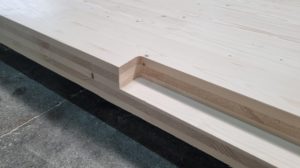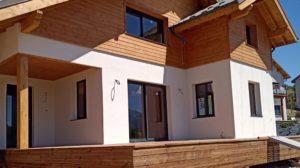From 2021 onwards, the NZEB standard is mandatory for all newly constructed buildings for which the building permit was issued after 31 December 2020. This means that all buildings built from now on must be nearly zero-energy buildings (nZEB: nearly Zero-Energy Building), i.e. very energy efficient. Another requirement is that this very low energy demand should be met as much as possible from renewable sources. While until now each of us managed the energy consumption of our homes in our own way, now the house has to be designed to respect EU requirements and those of the Ministry of Regional Development and Public Administration. It's no longer just about what each of us thinks about energy consumption and paying the bills, but about a Europe-wide requirement to protect resources and reduce the noxious emissions from burning fossil fuels. In new homes we will use less energy for heating air, water, cooling, air conditioning and ventilation. How can we do this? By building well insulated and well sealed houses so that energy losses are reduced to zero.

What makes a house energy efficient
For a building to be as energy efficient as possible, it must have an airtight envelope. It must be very well insulated, have efficient doors and windows, be oriented so that it benefits from solar gain in winter, and have ventilation systems with heat recovery. The Passive House is currently the most energy-efficient construction concept and a benchmark in low-energy house building. Passive houses are being built all over the world, but in Romania there are already such houses, some of which have been certified by the Passivhaus Institute in Germany.
Passive house certification is awarded if certain criteria are met. Measurements are taken to determine the energy efficiency of the house, as well as the indoor comfort benefits for residents. One of the requirements is high air tightness. To determine how airtight the house is, a specific test called leak test or blower-door test (described at length below). According to this test, a passive house must have less than 0.6 changes/hour. To give you an idea of the difference, Zecaph - a passive house standard energy efficiency designer and consultant - says that now in Romania, new construction is between 5 - 26 air changes per hour.
The benefits of a well-sealed house
The main advantage is lower heating and cooling costs. Very good sealing ensures that there is no uncontrolled air exchange between the inside of the house and the outside. Such an exchange would also mean a loss of heat from the inside to the outside in winter or a gain of heat from the outside to the inside in summer. The temperature difference between inside and outside causes the air to move, to circulate, and an unsealed house allows exchange with the outside. As a result, indoor thermal comfort will decrease, but to get back to the desired level requires additional energy consumption. This extra consumption will show up in your bills.
Another disadvantage of uncontrolled air exchange between inside and outside is condensation. Uncontrolled air movement also influences indoor humidity. The extra moisture in the air can condense in areas where there is no thermal insulation or where it is interrupted because the walls are colder. Permanent dampness leads to mold growth. There is a misconception that very good airtightness leads to condensation. Not so! The foils used for sealing allow water vapor to escape, but not air circulation.
If the tests carried out show that the building is well sealed, then the house will certainly also have a high level of sound insulation and you can be sure that the work on the building site has been well carried out and that the construction has no hidden defects.
How to seal your house on the building site
To seal the building perfectly, a foil is used which must be installed continuously on the inside, i.e. on the inside face of all walls, the roof and over the concrete floor slab. Design specialists have a rule - the pencil or red pencil rule - to determine a perfect seal. The rule says that on a section of your home design, you must be able to pencil over the seal coat without lifting it off the paper.
In order to ensure a perfect seal, the installation team has to pay very close attention to all the joints between the sealing foils. The sheets overlap and are taped with special adhesive tape. There are sensitive areas, such as around doors and windows, and balconies that have an outside platform, where sealing must be done very carefully. Installation crews also need to work carefully to ensure that the penetrations made to fit the tubing do not damage the sealing foil.
To demonstrate that the fitted foil is continuous, with no punctures leading to air leakage, the blower-door test is carried out.
Leak test or blower-door test or the blower door. Why is the blower-door test necessary?
This test is used to check the airtightness of the building, the quality of the work carried out and to identify any areas of leakage, where air is leaking, and then to rectify them. Vulnerable areas are those at the joints of envelope components, windows, doors, at penetrations of ducts or electrical routes. The airtightness test is performed to measure the airtightness of a home and answers two questions, "how much air is entering or leaking out of the house?" and "where is it going?".
For the test, the blower door incorporating a powerful fan is fitted tightly into the gap or frame of an external door of the house. The airtightness is ensured with a flexible foil that seals the door gap where the blower is installed. The fan blows air in or out and thus creates a pressure difference between inside and outside of 50 Pascals. The measurements made during the test are to determine the value n50 which shows the number of air changes per hour at a pressure difference of 50 Pa. The value allows for the detection of leaks by means of an anemometer (air velocity measuring instrument), a smoke machine or thermoscan. During the test, an auditor can observe from the outside of the house the areas where air leakage occurs. The places where installation faults or air tightness problems are usually around windows, doors, at the junctions between house elements (walls/roof) or in areas where wiring or plumbing tubes penetrate the walls. With the thermoscan and smoke generator even the smallest heat losses or temperature differences are located by the blower door test. In addition to these qualitative observations, the blower door also provides a quantitative measurement of a house's air losses. Based on the collected data, the energy losses of the building can be estimated and improvements can be made.
Ideally, two blower door tests should be carried out on site, one at an intermediate stage of construction and one at the end. The benchmark test, however, is the one at the end, when the construction is finished and the finishing touches are completed. This test is mandatory for passive house certification.
Why is home sealing important?
Sealing your home is considered one of the most effective ways to reduce energy consumption for heating and cooling. If the house envelope is airtight, there is no uncontrolled exchange of air between the inside and outside of the house. If there were, warm air from inside would be lost and cold air from outside would come in. Or vice versa, depending on the season. To get back to the desired comfort level will require additional energy consumption, which will be reflected in the bills. Since we want low heating costs, it is essential that there is no heat loss. In addition to high heating costs and thermal discomfort in your home, a leaky envelope creates many other problems. Uncontrolled exchange of air between inside and outside can lead to condensation and subsequently to mold growth which, over time, will affect the building materials, the air in the house and the health of the inhabitants.
Proper and efficient building air sealing has benefits that increase the durability of the home, improve comfort and air quality. Keep in mind that any place where heat is lost can make a difference in cost and comfort. Anyone thinking of building, buying or retrofitting a home should consider having an airtightness test performed.




































Add comment